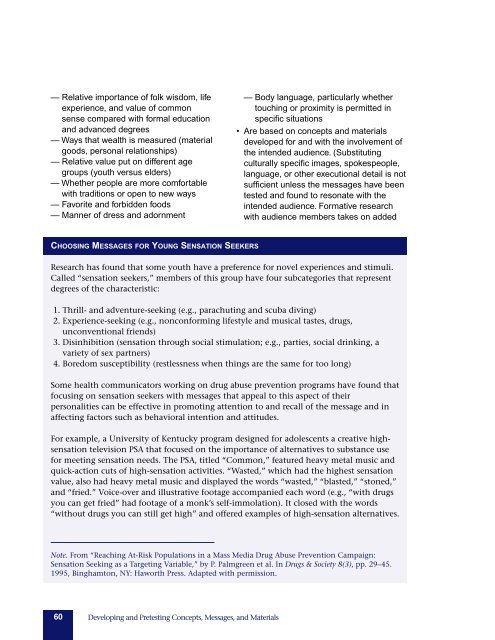pink-book
pink-book
pink-book
You also want an ePaper? Increase the reach of your titles
YUMPU automatically turns print PDFs into web optimized ePapers that Google loves.
— Relative importance of folk wisdom, life<br />
experience, and value of common<br />
sense compared with formal education<br />
and advanced degrees<br />
— Ways that wealth is measured (material<br />
goods, personal relationships)<br />
— Relative value put on different age<br />
groups (youth versus elders)<br />
— Whether people are more comfortable<br />
with traditions or open to new ways<br />
— Favorite and forbidden foods<br />
— Manner of dress and adornment<br />
— Body language, particularly whether<br />
touching or proximity is permitted in<br />
specific situations<br />
• Are based on concepts and materials<br />
developed for and with the involvement of<br />
the intended audience. (Substituting<br />
culturally specific images, spokespeople,<br />
language, or other executional detail is not<br />
sufficient unless the messages have been<br />
tested and found to resonate with the<br />
intended audience. Formative research<br />
with audience members takes on added<br />
CHOOSING MESSAGES FOR YOUNG SENSATION SEEKERS<br />
Research has found that some youth have a preference for novel experiences and stimuli.<br />
Called “sensation seekers,” members of this group have four subcategories that represent<br />
degrees of the characteristic:<br />
1. Thrill- and adventure-seeking (e.g., parachuting and scuba diving)<br />
2. Experience-seeking (e.g., nonconforming lifestyle and musical tastes, drugs,<br />
unconventional friends)<br />
3. Disinhibition (sensation through social stimulation; e.g., parties, social drinking, a<br />
variety of sex partners)<br />
4. Boredom susceptibility (restlessness when things are the same for too long)<br />
Some health communicators working on drug abuse prevention programs have found that<br />
focusing on sensation seekers with messages that appeal to this aspect of their<br />
personalities can be effective in promoting attention to and recall of the message and in<br />
affecting factors such as behavioral intention and attitudes.<br />
For example, a University of Kentucky program designed for adolescents a creative highsensation<br />
television PSA that focused on the importance of alternatives to substance use<br />
for meeting sensation needs. The PSA, titled “Common,” featured heavy metal music and<br />
quick-action cuts of high-sensation activities. “Wasted,” which had the highest sensation<br />
value, also had heavy metal music and displayed the words “wasted,” “blasted,” “stoned,”<br />
and “fried.” Voice-over and illustrative footage accompanied each word (e.g., “with drugs<br />
you can get fried” had footage of a monk’s self-immolation). It closed with the words<br />
“without drugs you can still get high” and offered examples of high-sensation alternatives.<br />
Note. From “Reaching At-Risk Populations in a Mass Media Drug Abuse Prevention Campaign:<br />
Sensation Seeking as a Targeting Variable,” by P. Palmgreen et al. In Drugs & Society 8(3), pp. 29–45.<br />
1995, Binghamton, NY: Haworth Press. Adapted with permission.<br />
60 Developing and Pretesting Concepts, Messages, and Materials


